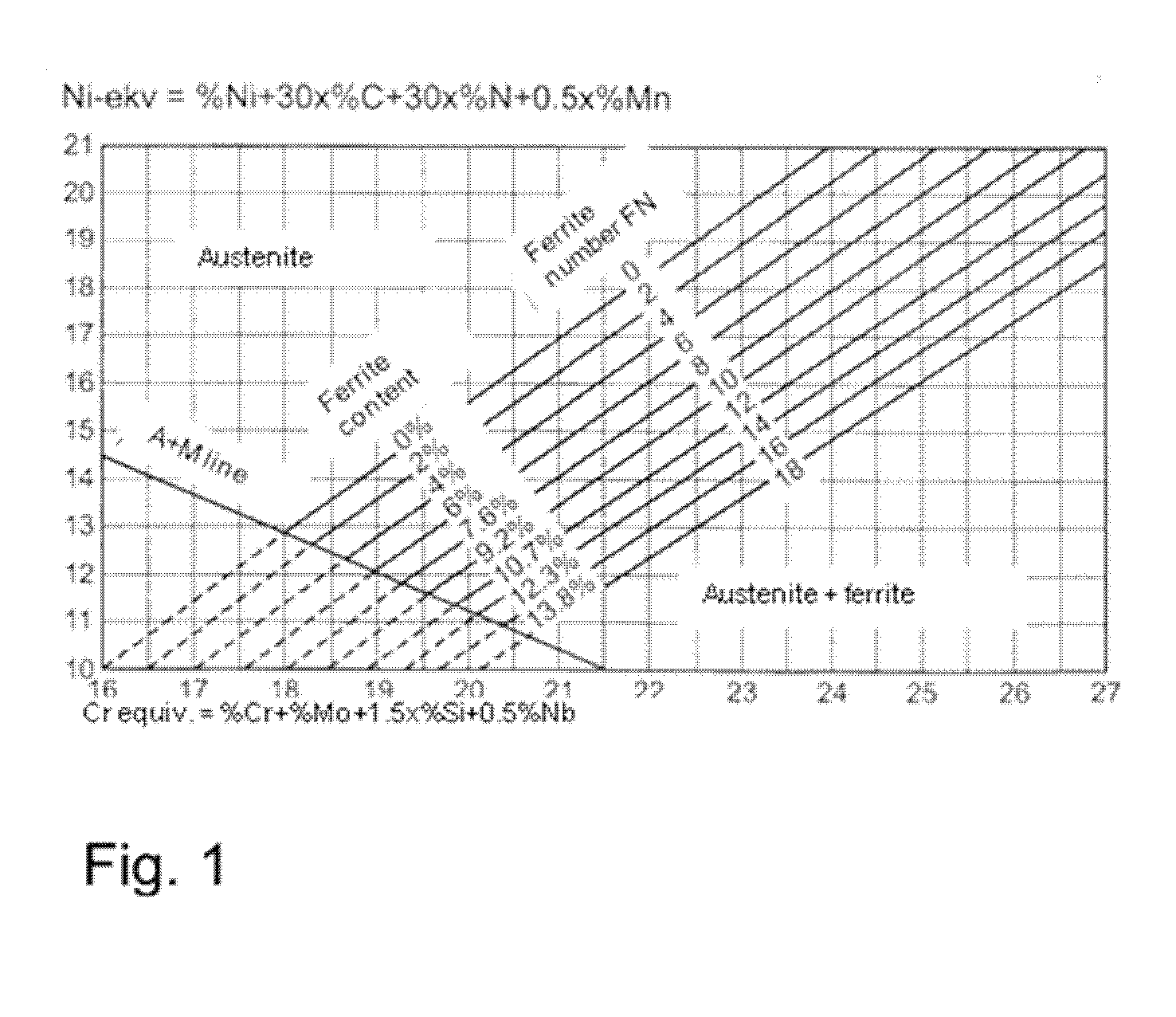Austenitic stainless steel product and a method for manufacturing same
a technology of stainless steel and product, which is applied in the direction of furnaces, furnace types, heat treatment furnaces, etc., can solve the problems of significant loss of formability of materials, limited use of structural materials, and low strength, and achieves good preservation of toughness, high yield strength, and durability of said equipment
- Summary
- Abstract
- Description
- Claims
- Application Information
AI Technical Summary
Benefits of technology
Problems solved by technology
Method used
Image
Examples
example 1
[0082]Strip manufactured from austenitic stainless steel SS 18 / 10 (304L), the thickness of which is initially 4 mm, containing a chemical composition according to the composition stated in Table 1.1 in addition to iron and non-specified impurities, was treated according to the invention to achieve improved formability and high strength. The austenitic strip was cold-formed by cold-rolling used the degrees of reduction of Table 1.2. At the same time the amount of martensite formed was determined using a Ferritescope MP30 measuring device (Fischer Instrumentation (G.B.) Ltd.) intended for measuring ferrite content. The readings obtained in the measurement were multiplied by 1.7, which is verified to have given the correct martensite content. It can be stated that even with a large reduction ratio the amount of martensite formed is rather low.
[0083]Next, heat treatment was performed for the test pieces with a 75% reduction ratio. Heat treatment was performed at five different temperatu...
example 2
[0088]The suitability of austenitic stainless steel SS18 / 8 (AISI 304L) for the treatment according to the invention was tested. Austenitic stainless steel, which contained 18.2% by weight chromium, 8.2% by weight nickel, 1.65% by weight manganese, 0.40% by weight silicon, 0.45% by weight copper, 0.050% by weight nitrogen and 0.022% by weight carbon, in addition to iron and non-specified impurities, was cold-formed by rolling to a total reduction ratio of 80%. After this the test piece was heat-treated, the heating rate being 200° C. / s, the annealing temperature being 800° C. and the annealing time, i.e. the holding time, being 2 minutes. After treatment 539 MPa was obtained for yield strength (Rp0.2) and 784 MPa for tensile strength (Rm). The toughness of the material measured with uniform elongation (Ag) was 34% and elongation to fracture (At) was 50%. The grain size was 2.5 μm and the proportion of non-recrystallization was 2%. It can be asserted that a steel product fulfilling th...
example 3
[0090]The suitability of austenitic stainless steel SS17 / 12 / 3 (AISI 316L) for the treatment according to the invention was tested. Austenitic stainless steel strip, which contained 17.3% by weight chromium, 11.8% by weight nickel, 2.67% by weight molybdenum, 1.74% by weight manganese, 0.42% by weight silicon, 0.28% by weight copper, 0.032% by weight nitrogen and 0.022% by weight carbon, in addition to iron and non-specified impurities, was cold-formed by rolling with a total reduction ratio of 80%. After this the test piece was heat-treated, the heating rate being 200° C. / s, the annealing temperature being 840° C. and the annealing time, i.e. the holding time, being 2 minutes. After treatment 571 MPa was obtained for yield strength Rp0.2, 814 MPa for tensile strength Rm. The toughness of the material measured with uniform elongation (Ag) before reduction was 41% and elongation to fracture at the time of fracture of a test rod (At) was 56%. The grain size was 2.5 μm and the proportio...
PUM
| Property | Measurement | Unit |
|---|---|---|
| grain size | aaaaa | aaaaa |
| tensile strength | aaaaa | aaaaa |
| grain size | aaaaa | aaaaa |
Abstract
Description
Claims
Application Information
 Login to View More
Login to View More - R&D
- Intellectual Property
- Life Sciences
- Materials
- Tech Scout
- Unparalleled Data Quality
- Higher Quality Content
- 60% Fewer Hallucinations
Browse by: Latest US Patents, China's latest patents, Technical Efficacy Thesaurus, Application Domain, Technology Topic, Popular Technical Reports.
© 2025 PatSnap. All rights reserved.Legal|Privacy policy|Modern Slavery Act Transparency Statement|Sitemap|About US| Contact US: help@patsnap.com


